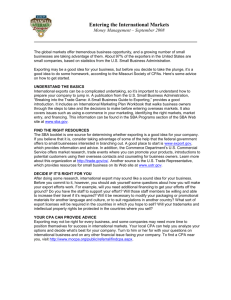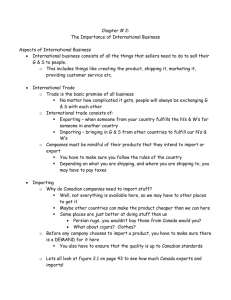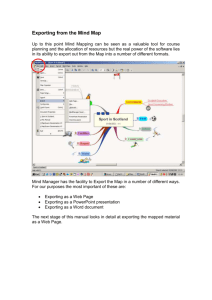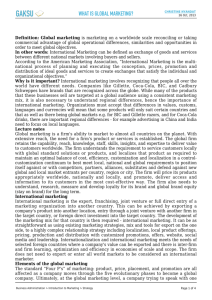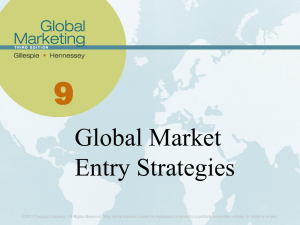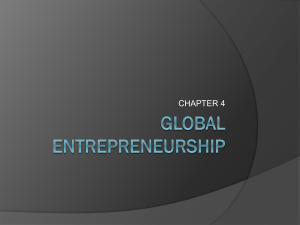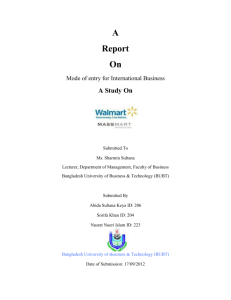INTERNATIONAL LAW-PaperCombined
advertisement
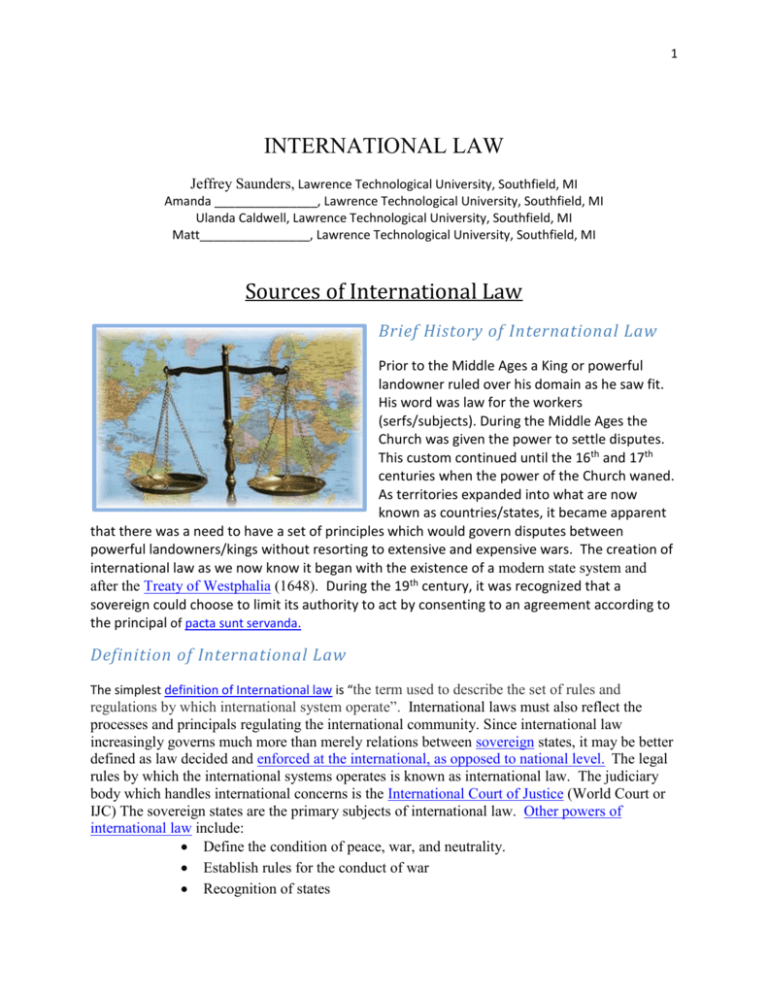
1 INTERNATIONAL LAW Jeffrey Saunders, Lawrence Technological University, Southfield, MI Amanda _______________, Lawrence Technological University, Southfield, MI Ulanda Caldwell, Lawrence Technological University, Southfield, MI Matt________________, Lawrence Technological University, Southfield, MI Sources of International Law Brief History of International Law Prior to the Middle Ages a King or powerful landowner ruled over his domain as he saw fit. His word was law for the workers (serfs/subjects). During the Middle Ages the Church was given the power to settle disputes. This custom continued until the 16th and 17th centuries when the power of the Church waned. As territories expanded into what are now known as countries/states, it became apparent that there was a need to have a set of principles which would govern disputes between powerful landowners/kings without resorting to extensive and expensive wars. The creation of international law as we now know it began with the existence of a modern state system and after the Treaty of Westphalia (1648). During the 19th century, it was recognized that a sovereign could choose to limit its authority to act by consenting to an agreement according to the principal of pacta sunt servanda. Definition of International Law The simplest definition of International law is “the term used to describe the set of rules and regulations by which international system operate”. International laws must also reflect the processes and principals regulating the international community. Since international law increasingly governs much more than merely relations between sovereign states, it may be better defined as law decided and enforced at the international, as opposed to national level. The legal rules by which the international systems operates is known as international law. The judiciary body which handles international concerns is the International Court of Justice (World Court or IJC) The sovereign states are the primary subjects of international law. Other powers of international law include: Define the condition of peace, war, and neutrality. Establish rules for the conduct of war Recognition of states 2 Dissolution of states Recognition of governments Rules of diplomacy and diplomatic etiquette Sources of International Law Traditionally, the sources of international law are regarded as being listed in Article 38 of the Statute of the International Court of Justice. These are: International Conventions whether general or particular establishing rules expressly recognized by 'the contesting states' International custom as evidence of a general practice accepted as law The general principles of law recognized by civilized nations Judicial decisions and the teachings of the most highly qualified publicists of the various nations (as subsidiary means for the determination of rules of law). Since WWII treaties have become the primary source of international laws. In subsequent years it has been argued that the United Nations and the Security Council and the General Assembly are additional sources of international law. Another source notes however, that ---it must be remembered that wherever a rule of international law may originate, it only becomes binding by the force of custom and through general acquiescence. This consensual view of international law is reflected in the 1920 Statute of the permanent Court of International Justice. Later, Article 38(1) of the 1946 Statute of the International Court of Justice further reflects this view (International Norms, 2004). Article 38(1) is also recognized as a definitive statement of the sources of international law. According to this Article the Court must apply at least two basic premises a. International conventions “expressly recognized by the contesting states” b. “International customs as evidences of a general practice accepted as law” Later a sub paragraph added the requirement that c. The general principles applied by the court were those that had been “the general principals of the law recognized by the civilized nations” 3 An additional subparagraph acknowledges that d. The Court is entitled to refer to “judicial decisions” and the most highly qualified juristic writings as subsidiary means for the determination of rules of law” (Sources of international law, 2012). Subdivisions of International Law There are several subsets of international law. Included are: Customary International Law wherein states follow certain practices and constraints consistently out of a sense of obligation Conventional International Law wherein the law is derived from international agreements and may be formulated in any manner the parties agree upon Public International Law which concerns itself only with questions of rights between several nations Private International Law deals with controversies between private persons arising out of situations having significance to more than one nation International organizations are also seen as subject to governed by international law. Other areas also regulated by international law include, international human rights law, international humanitarian laws and international trade laws (NAFTA). Doing Business Internationally Many businesses today have taken advantage of conducting and /or manufacturing business off shore. There are a number of ways in which businesses can take part in these types of transactions. The most common form of international business is the exporting of goods and services. Secondly business can establish a way of manufacturing those goods and services in foreign countries, to in turn sell in them in the United States and across the world. Exporting The export of goods and services can be conducted in two forms, direct and indirect. Direct exporting provides a U.S firm the opportunity to sign a sales contract with a foreign purchaser that describes the conditions in which shipment and payment will take place. Indirect exporting occurs when a U.S firm establishes a specialized marketing organization. . An addition to how exporting takes place is the involvement of the U.S firm during operations. Some U.S. firms may choose to have limited involvement in the international market. This creates an agency relationship. Exporting has had a significant impact on jobs in the United States and the continued growth of capital for many businesses. The article “Made In the USA : An export boom, discusses the impact exporting has made in the past five years. President Barack Obama stated during his election campaign that in order to overcome the recession we must increase the quantity of exporting goods and services. 4 Manufacturing Abroad The theory behind manufacturing plants abroad is, it will reduce cost for labor, shipping and raw materials. U.S. firms participate in these acts of business to increase their competitive stand point against other firms. The article “A tale of Apple, the iPhone, and overseas Manufacturing” discusses how former CEO Steve Jobs chose to have Apple products manufactured China to increase profitability, reduce the cost of labor and to produce the product in mass quantities. Manufacturing in foreign countries is conducted through either of the following procedures: Licensing As with any other licensing agreement, a form of payment must be established as a part of the contract. Foreign bases licensing payments may consist of a price per unit or percentage of the profits per units sold. Licensing of intellectual property rights is an important benefactor to all parties during a transaction. The firm granting the license receives profits from the sale of its goods and establishes a global reputation, while the firm receiving the license has the opportunity to exemplify a higher quality product. Franchising A franchise agreement provides an owner of a trademark the opportunity to “share” or use its trademark or trade name with a potential business owner(franchisee) under certain conditions and contract terms. Subway is an international trademark known for its franchising opportunities and popularity. Franchise owners pay a fee to utilize the trade name, which can be based on gross or net sales. 5 Wholly owned subsidiary or Joint Venture Once a wholly owned subsidiary is established a U.S. firm retains complete ownership of all the facilities, manufacturing plants or warehouses, and all conditions of operations while housed in the foreign country. Firms that establish a joint venture will only have part ownership and control of the operations taking place in a foreign country. The remaining portion of ownership is maintained by local owners in the foreign country or other foreign counterparts. All owners whether foreign or home based share liabilities, responsibilities and profits. Regulations of Specific Business Activities There are laws created between nations to restrict and or to facilitate international business. This implementation is necessary to protect the countries, economies, foreign policies, domestic politics as well as additional interests that will help increase the livelihood of trading within the global market. The nations can introduce five very important controls within international agreements. The agreements can include investment protections, export controls, import controls and trade agreements that minimize trade barriers. 1. Investment protection pertains to the property that a firm may have purchased in a foreign nation. There may be potential risks of that foreign government may expropriate the investment property. The owner is compensated for the loss property and this does not violate observed principles of international law, however, if the owner is not compensated then there is a violation. The remedies are usually resolved with lump-sum settlements between the United States and the nation that initiated the challenge. The nations have decided that it is necessary to address the potential risks by creating a guaranty within a national constitution or statutory laws and provisions within the international treaties. 2. Export controls are embodied within Article 1, Section 9, Clause 5 of the United States Constitution which state that Congress cannot impose any export taxes, therefore “No Tax or Duty shall be laid on Articles exported from any State.” They can, however, be creative in diversifying their efforts to either encourage or restrict exports. The technology industry is growing rapidly and the U.S. implemented the Export Administration Act of 1979, is used to restrict the flow of technological data and products. The Act has since been amended in August 31, 2001 and replaced with the International Emergency Economic Powers Act which is a streamlined and strengthened export control system that effectively promotes both U.S. national security and U.S. economic interests. The nations have commonly implemented export quotas, incentives subsidies that can encourage additional exporting to help enhance more global business. President Obama presented a speech on March 10, 2010 stating the importance of pushing exports to prevent a depression in the 21st Century. 3. Import controls are customized with prohibitions, quotas and tariff restrictions worldwide. In the United States, the Trading with the Enemy Act of 1917 ensures that we do not import goods from designated enemy nations. Additional laws protect the U.S. from importation of books that may influence insurrection against the nation, harmful agricultural products that may be a danger to our 6 animals and crops. The U.S. does not allow goods that may infringe the nation’s patents. The government has created an agency, the Federal Trade Commission, to investigate any infringement allegations and they are allowed to impose penalties on the violating foreign nation(s) if applicable. The United States has set quotas which will limit the amount of imported goods as well as tariffs, the tax on the imported goods. The tariff is the percentage of the value of the import. This tax has been used for political retaliation by some nations in the past. The United States has also created customized laws to focus on the unfair international trade practices of various countries. Dumping is the sale of imported goods at less than fair value which is decided by the price of those goods in the exporting country. Some countries hope to undersell the businesses to possibly monopolize the U.S. market with that product. The United States will impose an extra tariff call the antidumping duty to eliminate the potential threat. The two agencies that will investigate any allegations are the International Trade Commission (ITC) which assess the effects of dumping on domestic businesses and then seek the advice of President Obama to establish temporary import restrictions and the International Trade Administration (ITA), who decides if the goods are sold at less than fair value, then the amount of the antidumping duties are established and the costs may be retroactive to cover past dumping. 4. Trade agreements that minimize trade barriers contribute to the goal of eliminating the trade barriers which are restrictions on imports all together may enhance the world’s economic well-being. The World Trade Organization (WTO) was created in 1995, embodies world leading trading nations members to ensure that there is favorable export and import processes among them, this communication has also created regional trade agreements and associations that has helped simplify the their efforts. The European Union (EU) was created during the 1957 Treaty of Rome and their sufficient checks and balances within their governing authorities, the Council of Ministries which includes a representative from each nation that coordinates economic policies and they are regulated by a commission who are in turn monitored by an elected assembly. Canada, Mexico and the United States has created a regional trade agreement, the North America Free Trade Agreement (NAFTA) with the goal of eliminating the tariffs among themselves and creating a competitive advantage for them as they retain tariffs on the countries that are not included in their agreement. On August 5, 2004 the United States, Costa Rica, the Dominican Republic, El Salvador, Guatemala, Honduras and Nicaragua created The Central America-Dominican RepublicUnited States Free Trade Agreement (CAFTA-DR) the goal of this agreement is to reduce trade tariffs and improve the market between these nations. 5. U.S. Antitrust Laws are created to subject firms in foreign nations to recognize their own provisions and they also protect the foreign consumers and competitors from violations 7 committed by U.S. citizens. The U.S. has implemented the The Sherman Act of 1980 to ensure that their global trading is favorable at all times.

